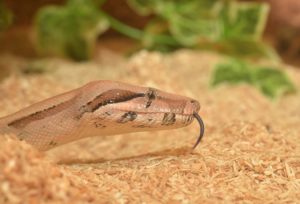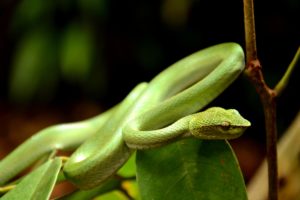5 Snake Behaviors Explained

If only all animals could wag their tail like a dog or purr like a cat to let us know they were happy. With no vocal cords, arms, or legs to let us know how they’re feeling, snakes can often be rather difficult to decipher, leaving owners confused and frustrated. Though all behavior is relative to breed and individual reptile, here is some common snake body language to help you understand your slithery friend a little better.
 1. Tongue flicking. You probably already know snakes use their tongues to smell. As a snake’s sight and hearing is quite limited, you’ll see them doing this often. Slow and controlled tongue flicks simply mean your snake is taking in its surroundings. Short, rapid tongue flicks usually indicate something has really grabbed your snake’s attention, such as a mouse or other food. In this case, your snake’s curiosity may lead them to bite, so be watchful of quick tongue flicks during handling to avoid any unwanted nips.
1. Tongue flicking. You probably already know snakes use their tongues to smell. As a snake’s sight and hearing is quite limited, you’ll see them doing this often. Slow and controlled tongue flicks simply mean your snake is taking in its surroundings. Short, rapid tongue flicks usually indicate something has really grabbed your snake’s attention, such as a mouse or other food. In this case, your snake’s curiosity may lead them to bite, so be watchful of quick tongue flicks during handling to avoid any unwanted nips.
2. Head wiggling. In many cases, this merely means your snake has smelled something new or interesting. If this happens every now and then, or especially during feedings, it’s very normal and nothing you should worry about. However, constant or severe head wobbling, sometimes to the point of being upside down, can be an indicator of a neurological problem or very high stress levels in your snake. This affliction is common in spider morphs of pythons, so be especially mindful of head movements if you own this particular type.
3. Changing eye color. A snake’s eyes turning opaque is one of the best indicators he or she is getting ready for a shed. You might notice the eyes becoming white, light blue, or another pale color. This is no cause for concern, as your snake has simply outgrown its skin, but the animal will likely be very uncomfortable as it prepares to shed, so handling should be avoided if possible.
 4. Coiling into “S” shape. Snakes are quite flexible, so you might find yours in the shape of an “S” at any given time. However, if your snake deliberately retracts its head and coils its neck into a curved stance, it is in defense mode and has positioned itself to strike. A strike may not come immediately, but your snake is at the ready to defend itself if needed. Along with this, your snake may hiss or puff up. It’s best to leave the animal alone at this point, but this is also a good time to check the temperature and humidity of its enclosure, as problems with these factors commonly lead to unhappy snakes.
4. Coiling into “S” shape. Snakes are quite flexible, so you might find yours in the shape of an “S” at any given time. However, if your snake deliberately retracts its head and coils its neck into a curved stance, it is in defense mode and has positioned itself to strike. A strike may not come immediately, but your snake is at the ready to defend itself if needed. Along with this, your snake may hiss or puff up. It’s best to leave the animal alone at this point, but this is also a good time to check the temperature and humidity of its enclosure, as problems with these factors commonly lead to unhappy snakes.
5. “Yawning.” Many snake lovers find this behavior rather cute, but it’s actually quite functional! Snakes don’t really “yawn” out of sleepiness, but instead open their mouths incredibly wide to gather air particles to smell. This is very similar to the way snakes flick their tongues to smell, but on a grander scale. Additionally, if a snake smells something interesting, they may “yawn” in order to stretch their jaws out for a big meal. As you’ve probably seen, snakes can open their mouths almost impossibly wide to swallow prey, so occasionally they’ll widen their mouths beforehand to make the eating process easier.
As pet owners, we all want our animals to lead the happiest lives they can. For snake owners, it’s important to remember that snakes don’t have the range of emotions that many other pets do. If you’re looking for signs of an overjoyed, cheerful snake, you probably won’t find them, but that’s not to say that snakes can’t live pleasant lives. Regular eating and drinking, normal basking patterns, and relaxed breathing are all signs of a content snake. And while your snake may not form an attachment to you like a dog or cat, curling up in a ball on you or staying generally close to you for heat is a good indicator your snake is comfortable and relaxed with you. It can be easy to get discouraged by a pet that doesn’t outwardly express joy and excitement, but by understanding snake behaviors, you can assure your wiggly little friend will live a healthy, peaceful life.
